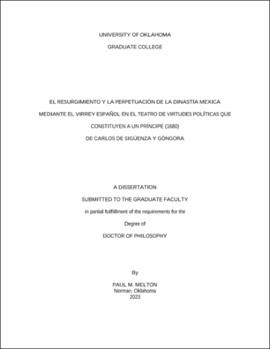| dc.contributor.advisor | Wray, Grady | |
| dc.contributor.author | Melton, Paul | |
| dc.date.accessioned | 2023-05-03T18:33:33Z | |
| dc.date.available | 2023-05-03T18:33:33Z | |
| dc.date.issued | 2023-04-12 | |
| dc.identifier.uri | https://hdl.handle.net/11244/337522 | |
| dc.description.abstract | The present thesis traces the process by which the creole savant Carlos de Sigüenza y Góngora (1645-1700) reconfigures the persona of the Spanish viceroy, Tomás de la Cerda (1638-1692), and integrates him into the ancient Mexica dynasty in Teatro de virtudes politicas que consituyen a un príncipe. Unlike previous 16th and 17th-century manuals known as literary “mirrors of princes”, Sigüenza’s Teatro de virtudes audaciously employs the eleven emperors of the ancient Mexica dynasty and a humanized version of the Mexica god Huitzilopochtli as models of political virtues. The novelty of the present study rests in an analysis of Sigüenza’s portrayal of the viceroy as possessing two bodies, one immortal and one mortal, and as being the prophesied prince in the succession of Mexica kings who never die. Sigüenza achieves this portrayal through emblematic art (the devise, impresse, and hieroglyph) in which he Christianizes and Romanizes the Mexica emperors as heroic and authentic historical entities rather than mere symbolic representations. Additionally, a thorough consideration of the 17th-century socio-political framework surrounding Teatro de virtudes signals the notion of an autochthonous viceroy who is challenged to embrace the motherland of the majority of his subjects as his own. Teatro de virtudes indicates its author’s interest in bridging to some extent the ethnic divide between the Spanish and indigenous populations to ensure peaceful coexistence. Although some explanations of Sigüenza’s later work, specifically Alboroto y motín, do not tally with the empathetic portrayal of the indigenous population expressed in Teatro de virtudes, this study also offers a historical contextualization of Alboroto y motín that clarifies much of the posited incongruence. | en_US |
| dc.language | es | en_US |
| dc.subject | Literature, Latin American. | en_US |
| dc.subject | Teatro de virtudes | en_US |
| dc.subject | Aztec emperors | en_US |
| dc.subject | viceroy | en_US |
| dc.title | El resurgimiento y la perpetuación de la dinastía Mexica mediante el virrey Español en el Teatro de virtudes políticas que constituyen a un príncipe (1680) de Carlos de Sigüenza y Góngora | en_US |
| dc.contributor.committeeMember | Lauer, Robert | |
| dc.contributor.committeeMember | Boggs, Bruce | |
| dc.contributor.committeeMember | Folsom, Raphael | |
| dc.date.manuscript | 2023-03 | |
| dc.thesis.degree | Ph.D. | en_US |
| ou.group | Dodge Family College of Arts and Sciences::Department of Modern Languages, Literatures, and Linguistics | en_US |
| shareok.nativefileaccess | restricted | en_US |
